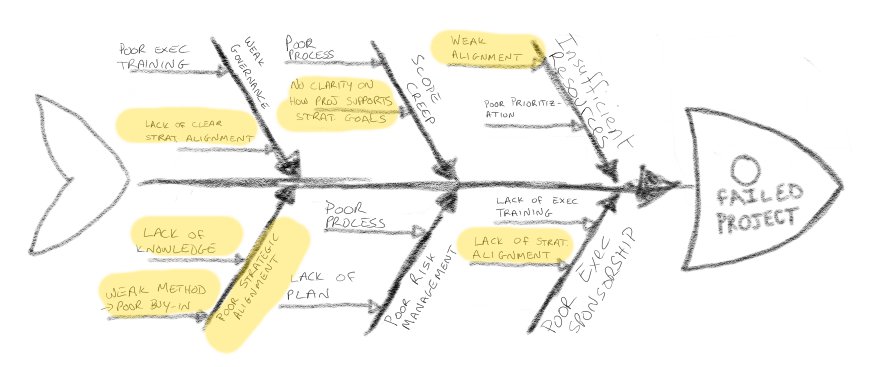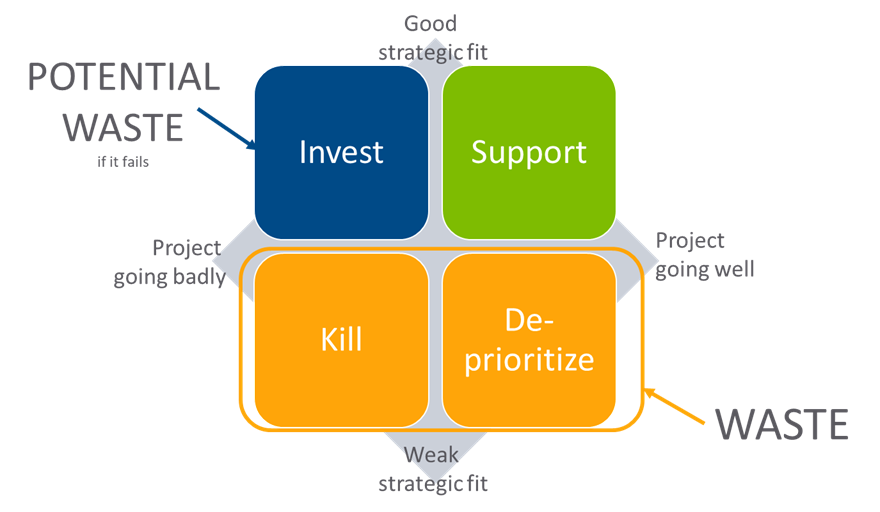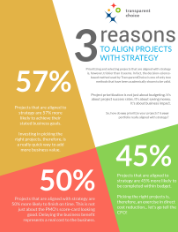Another project failure? Time to align projects to strategy
Updated:
Published:
Alright, let’s make this quick - I know this hurts. As a profession we still fail far too often. Project failure is a major source of waste and frustration in most organizations. Here are a few interesting nuggets of information:
- Only 37% of organizations deliver projects on time more often than not. In other words, 63% of organizations deliver more than 50% of their projects late! (UK data, Source: Wellingtone)
- The number of projects that are lost hook, line and sinker (“Failed project, budget lost”) has stubbornly remained above 30% for the last 6 years. (Source: PMI Pulse of the Profession 2017)
- 85% of organizations have a PMO (Source: State of the PMO, 2016)... but given that most organizations can’t even deliver half their projects on time
- The most common factor (37%) behind project failure is a lack of clear goals (or even a lack of alignment to corporate goals - source: PMI Pulse of the Profession 2017)
Why projects fail
So, let’s turn an eye towards the causes of project failure. There are so many studies sponsored by different people with different interests, but across those studies there are some common causes of project failure. The leading contenders include:
- Insufficient resources
- Poor executive sponsorship
- Scope creep
- Poor risk control
- Poor governance
- Poor alignment to strategy
This is where the fishbone chart comes in. We imagine the head of the fish as the failed project and the causes of failure become the ribs of the fish. Like this...

Strategic alignment is critical for project success
Projects that are aligned with strategy are more successful. According to the PMI, aligned projects are:
- 57% more likely to achieve their business goal
- 50% more likely to finish on time
- 45% more likely to finish on budget
Let’s revisit the fishbone diagram to see why. Now what we do is go down each of the ribs and ask, once again, why? I’ve put in some typical answers to this second-level-of-why.

And this is where we get to the point of this blog. When you do this, one factor keeps cropping up again and again on various ribs: strategic alignment.
To understand the connection between project success (and failure) and strategic alignment, it is important to recognize the following:
- If you don’t measure the strategic alignment of your projects, you can’t prioritize
- If you can’t prioritize, you can’t allocate resources
- If you can’t measure strategic alignment, it’s hard to “draw a line” on your portfolio… and you end up with too many projects
- If you understand what the project is FOR (it’s strategic goals), it’s easier to manage scope
- If you’re delivering projects that really are important to your execs, they will stay engaged
What IS strategic alignment?
Strategic alignment is a big topic but don’t worry, we have a handy Guide to Strategic Alignment. In summary, strategic alignment is a measure of how well your project supports the strategic goals of your organization.
It’s is NOT return on investment or net present value. Increasing financial performance may be ONE of your strategic goals, but others might include growing market share, reducing customer churn, reducing your order-to-cash time, etc.
There is a problem, however. Strategic alignment often means different things to different stakeholders within your business and this is what makes it seem difficult to deliver.
Strategic alignment is not a magic bullet. Just calculating a score doesn’t solve the problem of project failure. You have to USE strategic alignment to make decisions and to maintain focus. Here are seven key ways to use strategic alignment that will support your projects:
1. Project prioritization and selection
By making sure you have a clear picture of the strategic alignment your projects (both live projects and potential projects), you make the project prioritization and selection process much easier.
Essentially, you give the exec stakeholders the information they need to make a better, more balanced decision and lets you kill, once and for all, the temptation to jam in too many projects!
2. Resource allocation and scheduling
When you have a clear picture of which projects add the most value, you can make better, quicker and less contentious resource allocation decisions. If you have to choose between a project that’s well-aligned and one that’s not... easy! This makes resource planning easier too.
3. Portfolio health checks
You can now use your strategic alignment scores for each project, along with project performance data, to actively manage your portfolio towards success. You can implement health-checks at every governance meeting to ensure the most important projects are being supported and that they deliver their value.
4. Ensure exec engagement
Okay, you still have to train your execs to be good sponsors, but the first step is to motivate them to get involved in the first place. That’s where strategic alignment is a real game-changer. If you start every conversation with a reminder of the strategic benefit of this project, and if the project really IS important (which it is if it’s well-aligned), then motivation will not be your problem.
5. Better benefits realization
If you’ve measured a project’s strategic alignment, you can use that information to drive the project execution. Start at the end, start with the strategic goals you’re trying to achieve then work backwards through what needs to happen to get there, what your key decision points are, what resources you need… This refocusing on the goals delivers a much more coherent project plan and allows team-members to make better decisions because everything is focused on benefit, not on features.
6. Improving scope management
And if everything is focused on benefit and not on features, that improves scope creep management. You can use your “strategic goals” to evaluate the value of and change requests. Change requests that don’t improve the ability to achieve your goals should be deprioritized. Those that support the strategic intent of the project should be emphasized.
7. Delivering Change Management
I’m not talking about scope management here, I’m talking about the ability to actually implement organizational change so you realize the benefit of the project. This is a real value-killer if you don’t do it right. Again, being clear and transparent about the strategic goals of your project lets you engage with stakeholders, to get them involved in the change management process.
Getting started
This is not just bluff and smoke. The best performing organizations deliver 88% of their projects on time. Only 10% of their projects run late and they deliver the business benefit of their projects 92% of the time (view this infographic to see the detail).
And the biggest difference between high performers and the rest?
They focus on strategic alignment.
A great way to get started is to do a portfolio health-check. Take a look at your portfolio and plot it on this map.

You’ll quickly find out which projects should, and should not, be there and where you need to allocate resources to deliver real value.
You can sign up for a free session where we will show you how to do this. This will help you clearly identify where improvement is needed and what the benefit of an improved strategic alignment would be.
However you do it, commit to it. Get your portfolio aligned to strategy and do it quickly.
None of us want projects to fail or to miss their intended target. As much as I like fishbone diagrams, I’d rather not have to use them to diagnose the causes of project failure.

